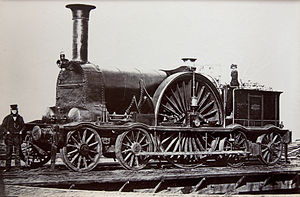4-2-4T
 |
|||||||||||||||

Pearson 4-2-4T no. 44 of the Bristol and Exeter Railway, c. 1854
|
|||||||||||||||
|
|||||||||||||||
|
|||||||||||||||
| Equivalent classifications | |
|---|---|
| UIC class | 2A2 |
| French class | 212 |
| Turkish class | 15 |
| Swiss class | 1/5 |
| Russian class | 2-1-2 |
| First known tank engine version | |
|---|---|
| First use | 1853 |
| Country | United Kingdom |
| Locomotive | Pearson 4-2-4T |
| Railway | Bristol and Exeter Railway |
| Designer | James Pearson |
| Builder | Bristol and Exeter Railway |
Under the Whyte notation for the classification of steam locomotives, 4-2-4 represents the wheel arrangement of four leading wheels on two axles, two powered driving wheels on one axle, and four trailing wheels on two axles. This type of locomotive is often called a Huntington type.
The configuration was most often used for tank engines, which is noted by adding letter suffixes to the configuration, such as 4-2-4T for a conventional side-tank locomotive, 4-2-4ST for a saddle-tank locomotive, 4-2-4WT for a well-tank locomotive and 4-2-4RT for a rack-equipped tank locomotive.
This wheel arrangement was mainly used on various tank locomotive configurations. Eight 4-2-4 well- and back-tank locomotives which entered service on the Bristol and Exeter Railway in 1853 appear to have been the first with this wheel arrangement. The engine was designed by James Pearson, the railway company's engineer, and featured single large flangeless driving wheels between two supporting four-wheeled bogies. The water was carried in both well- and back-tanks, leaving the boilers exposed in the same way as on most tender locomotives.
In 1923, the South African Railways (SAR) conducted trials with a prototype petrol-paraffin powered road-rail tractor and, in 1924, placed at least two Dutton steam rail tractors in service on the new 2 ft (610 mm) narrow gauge line between Naboomspruit and Singlewood in Transvaal. One of the latter had a 4-2-4 wheel arrangement.
The designer, Major Frank Dutton, SAR Signal Engineer and the Motor Transport Superintendent, argued that a rubber tyre in contact with a hard road would be better at transferring tractive power than a steel wheel on steel rail. At least two Dutton Rail Tractors were built, both steam-powered and both rebuilt by the Britannia Engineering Works of Johannesburg from Yorkshire steam tractors.
...
Wikipedia
